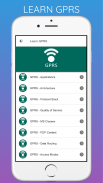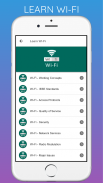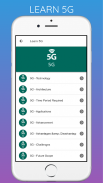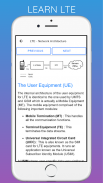










Learn All Telecom Technology Tutorials Offline ⭐️

คำอธิบายของLearn All Telecom Technology Tutorials Offline ⭐️
Learn 5G
5G is the Fifth Generation technology. It has many advanced features potential enough to solve many of the problems of our mundane life.
Learn CDMA
Code Division Multiple Access (CDMA) is a channel access method normally used by 3G radio communication technology as well as in some other technologies.
Learn FTTH
More commonly known as “Future Proof”, Fiber to the home (FTTH) is a new technology to deliver a communication signal over optical fiber. It is an efficient and economic substitute of existing copper infrastructure including telephone and coaxial cable.
Learn GPRS
General Packet Radio Service (GPRS) is a Mobile Data Service accessible to GSM and IS-136 mobile phones users. This service is packet-switched and several number of users can divide the same transmission channel for transmitting the data.
Learn GSM
This tutorial has been designed for readers who want to understand the basics of GSM in very simple terms. This tutorial provides just about enough material to have a solid foundation on GSM from where you can move on to higher levels of expertise.
Learn i-mode
NTT DoCoMo's i-mode is a mobile internet service popular in Japan. i-Mode was invented by a team led by Mari Matsunaga in February 1999 at NTT DoCoMo. This tutorial explains the basic concepts and applications of i-Mode.
Learn LTE
This tutorial has been designed for audiences with a need to understand the LTE technology basics in very simple terms. This tutorial will give you enough understanding on LTE technology from where you can take yourself at higher level of expertise.
Learn NGN
Next Generation Networks (NGN) is a part of present-day telecommunication system, which is equipped with capabilities to transport all sorts of media, such as voice, video, streaming audio/video, text, etc. NGN is developed around the concept of packet switching as in Internet Protocol architecture.
Learn Session Initiation Protocol
SIP is a signalling protocol designed to create, modify, and terminate a multimedia session over the Internet Protocol. It is an application layer protocol that incorporates many elements of the Hypertext Transfer Protocol (HTTP) and the Simple Mail Transfer Protocol (SMTP).
Learn Telecom Billing
Telecom Billing is a process of collecting usage, aggregating it, applying required charges and finally generating invoices for the customers. Telecom Billing process also includes receiving and recording payments from the customers. This tutorial gives you a complete understanding on Telecom Billing.
Telecommunication Switching Systems and Networks (TSSN)
This tutorial will help you understand the different aspects of telecommunication switching systems. It is designed to deliver knowledge about the basic concepts of telephony.
Learn UMTS
The Universal Mobile Telecommunications System (UMTS), based on the GSM standards, is a mobile cellular system of third generation that is maintained by 3GPP (3rd Generation Partnership Project).
Learn WAP
WAP is an international standard establishing how mobile devices can access information on the Internet. It is a widely used set of protocols used on wireless devices such as mobile phones and PDAs. This tutorial helps you in understanding WAP technology starting from its basics.
Learn Wi-Fi
WiFi is primarily a local area networking (LAN) technology designed to provide in-building broadband coverage. It is based on IEEE 802.11 specification. This tutorial gives you a basic understanding on WiFi.
Learn WiMAX
WiMAX is one of the hottest broadband wireless technologies around today.It is based on IEEE 802.16 specification and it is expected to deliver high quality broadband services. This is a brief tutorial that covers the fundamentals of WiMAX.
Learn WML
WML is an XML language used to specify content and user interface for WAP devices like PDA and Mobile Phones. The WAP forum provides a DTD for WML.
เรียนรู้ 5G
5G เป็นเทคโนโลยียุคที่ห้า มันมีคุณสมบัติขั้นสูงมากมายที่มีศักยภาพเพียงพอที่จะแก้ปัญหาต่าง ๆ ของชีวิตทางโลกของเรา
เรียนรู้ CDMA
Code Division Multiple Access (CDMA) เป็นวิธีการเข้าถึงช่องสัญญาณที่ปกติใช้โดยเทคโนโลยีการสื่อสารทางวิทยุ 3G เช่นเดียวกับในเทคโนโลยีอื่น ๆ
เรียนรู้ FTTH
ไฟเบอร์ที่รู้จักกันทั่วไปว่า“ Future Proof” ไฟเบอร์สู่บ้าน (FTTH) เป็นเทคโนโลยีใหม่ในการส่งสัญญาณการสื่อสารผ่านใยแก้วนำแสง มันเป็นสิ่งทดแทนที่มีประสิทธิภาพและประหยัดของโครงสร้างพื้นฐานทองแดงที่มีอยู่รวมถึงสายโทรศัพท์และคู่สาย
เรียนรู้ GPRS
General Packet Radio Service (GPRS) เป็นบริการข้อมูลมือถือที่ผู้ใช้โทรศัพท์มือถือ GSM และ IS-136 สามารถเข้าถึงได้ บริการนี้มีการสลับแพ็คเก็ตและผู้ใช้หลายคนสามารถแบ่งช่องส่งสัญญาณเดียวกันสำหรับการส่งข้อมูล
เรียนรู้ระบบ GSM
บทช่วยสอนนี้ได้รับการออกแบบมาสำหรับผู้อ่านที่ต้องการเข้าใจพื้นฐานของ GSM ในแง่ง่าย ๆ บทช่วยสอนนี้มีเนื้อหาที่เพียงพอเกี่ยวกับการสร้างรากฐานที่มั่นคงในระบบ GSM จากที่ที่คุณสามารถเลื่อนไปสู่ระดับความเชี่ยวชาญที่สูงขึ้น
เรียนรู้โหมด i
i-mode ของ NTT DoCoMo เป็นบริการอินเทอร์เน็ตบนมือถือยอดนิยมในญี่ปุ่น i-Mode ถูกคิดค้นโดยทีมนำโดย Mari Matsunaga ในเดือนกุมภาพันธ์ 1999 ที่ NTT DoCoMo บทช่วยสอนนี้อธิบายถึงแนวคิดพื้นฐานและแอปพลิเคชันของ i-Mode
เรียนรู้ LTE
บทช่วยสอนนี้ได้รับการออกแบบมาสำหรับผู้ชมที่มีความต้องการที่จะเข้าใจพื้นฐานเทคโนโลยี LTE ในแง่ง่ายมาก บทช่วยสอนนี้จะให้ความเข้าใจเพียงพอเกี่ยวกับเทคโนโลยี LTE ซึ่งคุณสามารถยกระดับความเชี่ยวชาญในระดับที่สูงขึ้นได้
เรียนรู้ NGN
Next Generation Networks (NGN) เป็นส่วนหนึ่งของระบบการสื่อสารโทรคมนาคมในปัจจุบันซึ่งมีความสามารถในการขนส่งสื่อทุกประเภทเช่นเสียงวิดีโอสตรีมมิ่งเสียง / วิดีโอข้อความ ฯลฯ NGN ได้รับการพัฒนาตามแนวคิดของ การสลับแพ็คเก็ตในสถาปัตยกรรมอินเทอร์เน็ตโปรโตคอล
เรียนรู้โปรโตคอลการเริ่มต้นเซสชัน
SIP เป็นโปรโตคอลการส่งสัญญาณที่ออกแบบมาเพื่อสร้างแก้ไขและยุติเซสชันมัลติมีเดียผ่านอินเทอร์เน็ตโปรโตคอล เป็นโปรโตคอลชั้นแอปพลิเคชันที่รวมองค์ประกอบหลายอย่างของ Hypertext Transfer Protocol (HTTP) และ Simple Mail Transfer Protocol (SMTP)
เรียนรู้การเรียกเก็บเงินโทรคมนาคม
การเรียกเก็บเงินเทเลคอมเป็นกระบวนการรวบรวมการใช้งานการรวมการใช้การคิดค่าธรรมเนียมที่จำเป็นและในที่สุดก็สร้างใบแจ้งหนี้ให้กับลูกค้า กระบวนการเรียกเก็บเงินเทเลคอมยังรวมถึงการรับและบันทึกการชำระเงินจากลูกค้า บทช่วยสอนนี้จะช่วยให้คุณเข้าใจอย่างสมบูรณ์เกี่ยวกับการเรียกเก็บเงินโทรคมนาคม
ระบบชุมสายโทรคมนาคมและเครือข่าย (TSSN)
บทช่วยสอนนี้จะช่วยให้คุณเข้าใจในแง่มุมต่าง ๆ ของระบบชุมสายโทรคมนาคม มันถูกออกแบบมาเพื่อส่งความรู้เกี่ยวกับแนวคิดพื้นฐานของโทรศัพท์
เรียนรู้ UMTS
Universal Mobile Telecommunications System (UMTS) เป็นไปตามมาตรฐาน GSM เป็นระบบเซลลูล่าร์มือถือรุ่นที่สามที่ดูแลโดย 3GPP (โครงการหุ้นส่วนรุ่นที่ 3)
เรียนรู้ WAP
WAP เป็นมาตรฐานสากลที่กำหนดว่าอุปกรณ์เคลื่อนที่สามารถเข้าถึงข้อมูลบนอินเทอร์เน็ตได้อย่างไร เป็นชุดโปรโตคอลที่ใช้กันอย่างแพร่หลายที่ใช้กับอุปกรณ์ไร้สายเช่นโทรศัพท์มือถือและพีดีเอ บทช่วยสอนนี้ช่วยให้คุณเข้าใจเทคโนโลยี WAP เริ่มตั้งแต่พื้นฐาน
เรียนรู้ Wi-Fi
WiFi เป็นเทคโนโลยีเครือข่ายท้องถิ่น (LAN) ที่ได้รับการออกแบบมาเพื่อให้บริการบรอดแบนด์ในอาคาร มันขึ้นอยู่กับข้อกำหนด IEEE 802.11 บทช่วยสอนนี้จะช่วยให้คุณเข้าใจพื้นฐานเกี่ยวกับ WiFi
เรียนรู้ WiMAX
WiMAX เป็นหนึ่งในเทคโนโลยีไร้สายบรอดแบนด์ที่ร้อนแรงที่สุดในปัจจุบันโดยใช้มาตรฐาน IEEE 802.16 และคาดว่าจะให้บริการบรอดแบนด์ที่มีคุณภาพสูง นี่คือบทช่วยสอนสั้น ๆ ที่ครอบคลุมพื้นฐานของ WiMAX
เรียนรู้ WML
WML เป็นภาษา XML ที่ใช้เพื่อระบุเนื้อหาและส่วนติดต่อผู้ใช้สำหรับอุปกรณ์ WAP เช่น PDA และโทรศัพท์มือถือ ฟอรัม WAP จัดให้มี DTD สำหรับ WML






















